Presented in partnership with Croatian National Tourist Board
Sitting in the Pannonian Basin, the north-easterly region of Slavonia has long been considered Croatia’s bread basket. It’s a land shrouded in legend and shaped by nature, with a food scene that bears influence from the many cultures that have called it home over the centuries. Join 50 Best for an insider’s guide to its culinary heart, unique culture and incredible landscapes
Point to Slavonia on a map – and you’d be forgiven for perhaps needing to take a moment before pushing the pin. Think of Croatia, and it’s usually the country’s long swathe of Adriatic coast that first springs to mind. But that’s only a mere snippet of the story: this unsung gem of a region remains as untouched as many of its traditions. Taking pride of place on the country’s north-eastern expanse – wedged between Hungary to the north, Serbia to the east, and Bosnia and Herzegovina to the south – Slavonia is a place where nature leads and a sense of heritage echoes loudly across the terrain.
Towering forests of oak and dense, silver-tinged beech. Blossoming banks and hills dotted with turrets and forts. Lush valleys and languid rivers. Historic castles and villages seemingly held in time. It’s a scene that would look at home hanging on the walls of an art gallery. Indeed, such a vignette could in itself provide enough draw for the modern traveller, especially with its scope for hiking, cycling and outdoor pursuits..jpeg)
Slavonia is one of Croatia's most picturesque regions and a hotbed of great gastronomy (Image: Siniša Uštulica, courtesy of Croatian National Tourist Board)
But those hungry to travel deeper are rewarded with culinary excellence at every turn. Hearty shepherd’s stews, lake fish doused with paprika, fantastic smoked meats and tempting pastries and breads – you can taste the region in every bite. And that’s before you’ve even gotten to the protected plum brandy (šljivovica rakija) and excellent graševina wine that’s emblematic of the area. From its foodways to its architecture, its folklore and beyond, this idiosyncratic region dishes up an authentic sense of place across the board. So, journey within to discover the wonders of this veritable land of plenty.
The lay of the land
Nestled within the country’s green interior – a world of big skies and bigger appetites – life moves to the rhythm of the seasons. To understand Slavonia’s culinary riches, first you need to grasp the region’s topography. Rising from the Pannonian Sea more than 350 million years ago, what was once awash with blue is today a patchwork of lush islets, forests and golden fields.
With a gentle climate of clement summers and little rainfall, the fertile Pannonian plains have long been stocking Croatia’s plentiful larder. Indeed, the Slavonian plain is the country’s largest fertile area. The soil here – a silty loam enriched by the confluence of the Danube, Sava and Drava rivers – has been tilled for some 8,000 years, perhaps even earlier if the neolithic vestiges found across the region are anything to go by (visit the Vučedol Culture Museum to discover more). Lush pastures and forests have long tempted hunters and foragers for their bounty, while fishers find its rivers and lakes replete. Meanwhile the flat lowlands yield a bedrock of corn, wheat and rye to bolster it all.
Taste for tradition
Tables across Slavonia are practically an ode to slow food, with regional pride imbued into each culinary creation. Whether dining low-key and local in a sleepy village or hitting up the city go-tos, you can expect authentic plates laden with fresh produce, prepared by devoted cooks and chefs who give due reverence to each ingredient. Culinary inflections nod to the people who’ve passed through this land: consider it a gastronomic mélange with gentle accents picked up from Germany, Austria, Hungary, Turkey, Italy and Bosnia along the way.
Spices are used generously across the region’s specialities, in particular paprika, whose earthy hue brings vibrancy to everything from charcuterie to stews. Fiš-paprikaš is one of Slavonia’s most beloved dishes, a fish soup laden with hot paprika with ties to a Hungarian past. Then there’s fish perkelt (stew) with peppers, tomato and garlic served on a bed of pasta (a nod to the Romans, no doubt), and baked pijani šaran (literally: drunken carp) stuffed with garlic and cooked on sliced potato.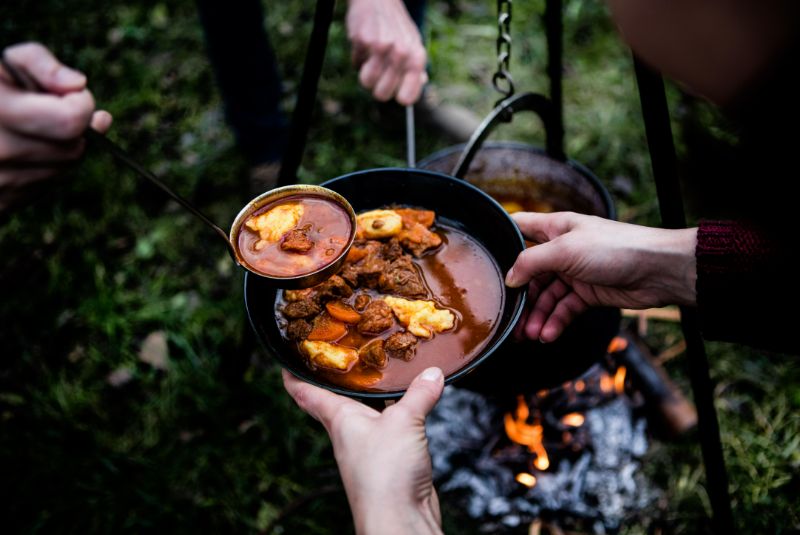
Čobanac is a traditional stew from Slavonia cooked in a cauldron over an open flame (Image: Maja Danica Pečanić, courtesy of Croatian National Tourist Board)
Freshwater fish – carp, catfish, pike, perch – seared on open flame is another flavoursome favourite. And the iconic shepherd’s stew (čobanac) is almost alchemic. Slow-cooked in a cauldron-style vessel over fire, it’s a medley of spicy peppers, onion, beef and pork, sometimes game (the forests offer superlative wild fare) or lamb, with tomatoes and wine. All that’s needed to finish it is a lick of cream and perhaps some dumplings. It’s a food style emblematic of an agrarian lifestyle.
The peppers used across such dishes also make their way into ajvar, a near-ceremonial savoury preserve that makes use of surplus produce at the end of the summer season. On hand through the cooler months (along with homemade pickles like sauerkraut and rasol), it’s a perfect foil for the myriad cured meats made locally. At one time, every household reared its own pig – the hardy black Slavonian has flecked the fields since the 19th century, feeding on acorns, corn and clover to create unrivalled flavour – and the scent of the smokehouse provides an evocative backdrop to village life to this day.
Kulen is the hero of Slavonian gastronomy. Revered across the nation, Baranjski kulen was the first Croatian food to gain protected status. Baranja’s deep Hungarian roots see hand-cut pork mixed with garlic and paprika (sweet and hot) then encased, brined and cured for a few months before being smoked in beech or hornbeam every few days for around a month. It’s a labour of love – one still regularly performed at home – but the flavour is unrivalled.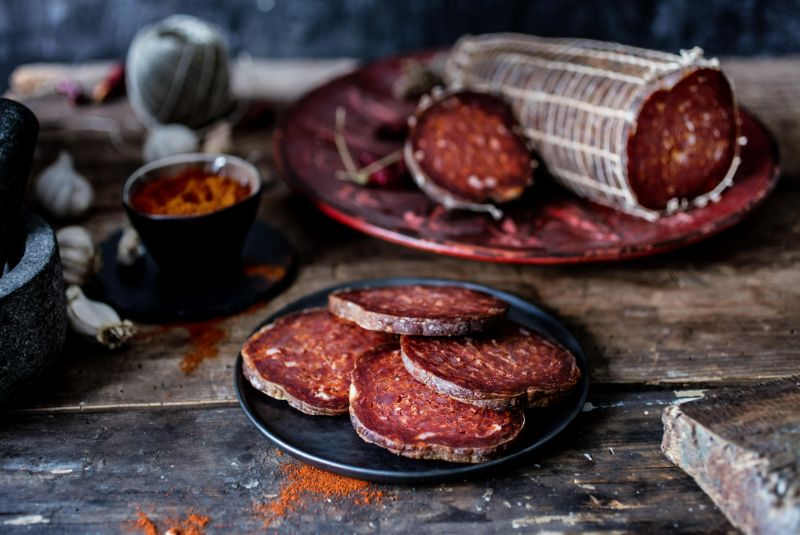
Kulen is a traditional sausage made with hand-cut pork, paprika and garlic and is a protected food in Croatia (Image: Maja Danica Pečanić, courtesy of Croatian National Tourist Board)
A nose-to-tail ethos is followed during the butchery: the fat is used in cooking (both sweet and savoury) and the pork skin forms the ultimate snack – čvarci, a crackling-like wonder that’s celebrated with its own festival in Karanac. You also find čvarci chopped up within the soft interior of čvarkuše, a scone-like roll. Other highlights might include the spicy švargla sausage, smoked ham, krvavica (blood sausage) and salenjaci – a dough enlivened by pork lard, nuts and jam.
A little table talk
Who doesn’t love to travel armed with an address book stuffed with fantastic restaurants to try? In truth, gourmet travellers in the know have probably been keeping Slavonia’s finest to themselves. Dine alongside the locals and you’ll see why.
While chefs here act as vanguards of tradition, many are bringing a modern edge to the region’s food scene. Just outside the historic city of Osijek – in eastern Slavonia – Crna Svinja is a great starting point for discovery. Here, chef Marinko Rotimoffer focuses on produce native to the surrounds and from the area’s ‘black soil’, showcasing an elegant modern Slavonian menu served in neo-rustic environs. Guinea fowl soup with dumplings, zander fritters, platters of cured meat and local cheese (including podlijevani – a soft, slightly salty pick), or gutsy pork tomahawk are the order of the day.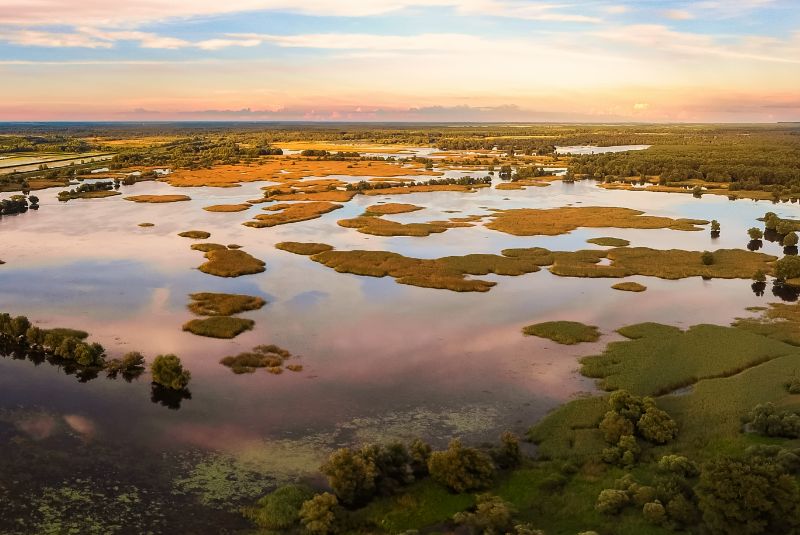
Kopački Rit nature reserve is one of Slavonia's most picturesque destinations (Image: Maja Ivo Biočina, courtesy of Croatian National Tourist Board)
Wild meat has been part of the regional diet here for centuries, and modern-country style Čingi Lingi Čarda is a perfect place to try it. Go for the bold Baranja venison with plum sauce or the heady game stew. The restaurant sits on the cusp of the glorious Kopački Rit Nature Park – a striking wetland (Europe’s largest) that’s home to deer, wild boar and some 300 species of birds, including black stork and white-tailed eagles. While fishing here is now forbidden, September’s ‘Fishing Day’ celebrations in Kopačevo honour the tradition with a village fair and, of course, plenty of food.
Also close by is Restaurant Citadela. You’ll know you’re in the right place when you get a whiff of the bubbling pots of fiš paprikaš, which line up neatly over fire, just as they have since 1978. The recipe is a secret; all you need to know is it's been passed through the Lazar family for generations, so you can consider this one tried and tested. Unfussy and bursting with flavour, it’s an essential waypoint.
While close to the backwaters of Kopački Rit, Osijek is still considered somewhat off the tourist trail. Austria’s nobles were drawn here during the 18th century, and the Habsburg heritage lives on. Spliced by the Drava, it’s defined by its baroque architecture, riverside promenades and elegant mansions. It’s hard to think the town was the centre of conflict during the 1990s Croatian War of Independence. One imagines this is partly the reason today’s chefs are so fervent in their passion for their region and its gastronomic potential.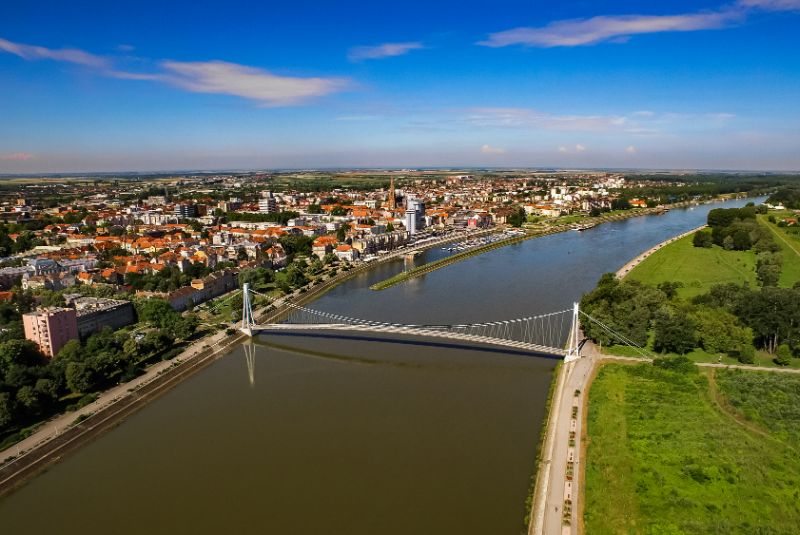
The city of Osijek is a historic location that houses a plethora of great restaurants (Image: Maja Danica Pečanić, courtesy of Croatian National Tourist Board)
At the family-run Lumiere, Antonela Balon-Hunjet’s elevated Slavonian dishes delight with a roll call that runs from homemade kulen and goose pâté to duck breast with red cabbage and local plum sauce, or pork loin with forest mushrooms. Elsewhere, Kod Javora has been delivering classic local fare from a choice spot on the promenade since 1999. A large terrace is the ideal place to sample Martina Štern’s super-fresh carp tartare.
If you opt to bed down at the cosy Hotel Waldinger, you’ll find a fine restaurant that playfully marries rustic recipes with contemporary spin. For something different, visit Franz Koch, a slick modern dining room headed up by Dino Bošnjaković and Goran Kunce, who are bringing globetrotting Asian flavours to the fore using exemplary Slavonian ingredients. Or you could go for the Bosnian-leaning menu at Project9 to taste culinary history in motion.
A warm welcome
Wherever you dine, you can expect to be welcomed with open arms by friendly hosts keen to share their culture and love of the land. Food informs every element of the quotidian here and acts as means of communication that grounds and forges relationships. Enter a Slavonian home and you’ll hardly be through the door before being offered some local speciality such as plum brandy, perhaps alongside a sweet something.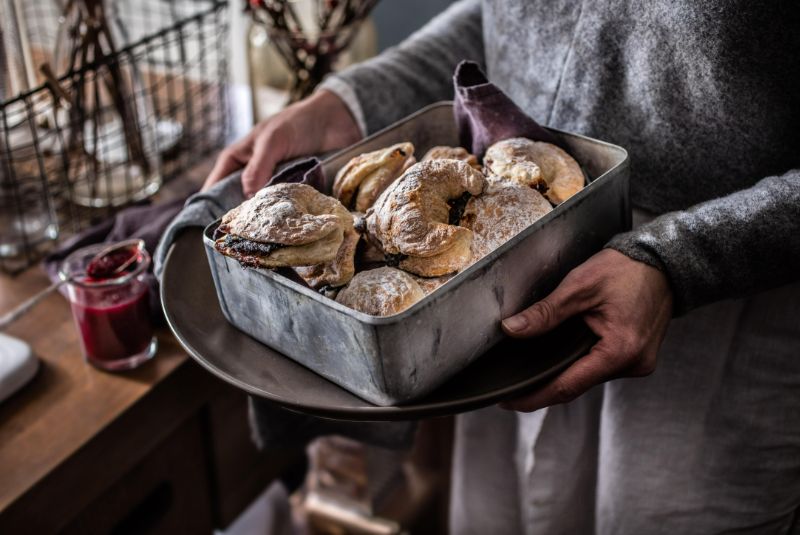
Don't leave Slavonia without trying a salenjaci: a sweet pastry snack filled with apricot or plum jam (Image: Maja Danica Pečanić, courtesy of Croatian National Tourist Board)
The area is known for its proclivity for pastries and dough-based bakes. See the nostalgic salenjaci (a sweet pastry enriched with pig fat and filled with homemade apricot or plum jam); honied ginger medenjak biscuits; puffs of fried poderane gaće, or the cinnamon-laced orahnjača (walnut) and makovnjača (poppyseed) tin rolls – ideal for slicing and sharing.
Slavonia’s cultural heart
Slavonia has always appealed to poets, artists and musicians, drawn by its bucolic scenery and strong folk tradition. Harvest festivals continue to honour the bounteous land, with locals donning traditional dress and playing tamburaška music as they have for centuries. Indeed, Unesco has noted festivals such as Gorjani’s Spring Procession of Ljelje as part of the list of ‘intangible cultural heritage’, so deep-rooted is its significance.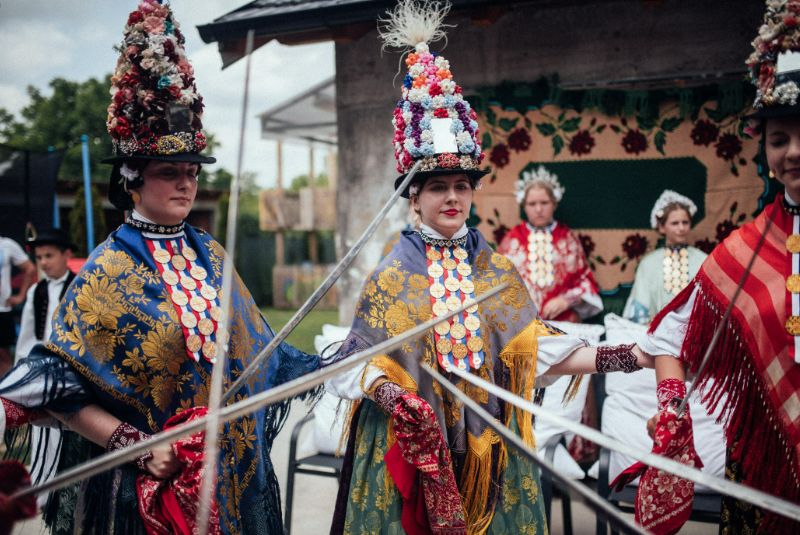
Witness a traditional Ljelje procession from Gorjani province for a taste of history (Image: Julien Duval, courtesy of Croatian National Tourist Board)
Close to the town of Đakovo, the May event recounts the fascinating legend of the Ottoman invasion during the 1500s. Đakovo is also known for its celebration of local embroidery (July); an April food festival, which includes a kulen championship, and the Lipizzaner Ball (December), honouring the legacy of the area’s iconic horses and related horsemanship. Nearby, grab a bite to eat in Garčin at Restaurant Ramarin. Set on a ranch between Dilje’s slopes and the River Sava, it serves a laid-back yet refined menu fuelled by local produce with wines from their winery in the neighbouring village.
On the wine trail
You don’t have to look far to find great wine in these parts. The scene – led by family-run and boutique wineries – has garnered a growing reputation in recent years. Wine has been produced around the medieval town of Ilok for two millennia. Climbing the hillside along the banks of the Danube, it delivers a high yield of fragrant and citrusy white graševina, famous traminac and silvanac, and the more familiar chardonnays and pinots. It’s also hero-ing the modern revival of Croatian reds with the likes of the bold, fruit-first blue frankish varietal – love child of belina bijela velika and black Sylvaner.
Unusually, the cellar doors all reside inside the town itself, with the ‘Old Cellars of Ilok’ dating back to the 16th century. Tie in a visit with a stay at Hotel Dunav, whose intimate restaurant majors in simply prepared river fish that’s best enjoyed on the atmospheric riverside terrace. Set on a picturesque estate, with views stretching across Srijem’s fields, Restaurant Principovac is another great option. The delicate iteration of rustic fare – rabbit pâté, grilled perch and slow-cooked Slavonian pork neck, all with paired local wines – won’t disappoint.
Slavonia's wineries are lauded for their production of graševina, traminac and silvanac varietals (Image: Siniša Uštulica, courtesy of Croatian National Tourist Board)
North of Osijek, Belje and the surrounds are also doing their bit. Head to award-winning modern winery Josic in Baranja (Hungarian, incidentally, for ‘Mother of Wine’) for an overview of their litany of bins: pinots, muscat, traminac, cabernet francs and sparkling blancs de blancs are all accounted for. The excellent on-site restaurant showcases spit-roast carp, game peke and a modern shepherd’s stew. Follow it up with an overnighter at rustic-chic Hotel Lug. Here, a cossetting cellar dining room offers a menu that puts contemporary spins on iconic Slavonian recipes in the spotlight.
In Slavonia’s western reach, the forested expanse of Papuk Geopark is a must-visit for its waterfalls, hot springs and stunning natural beauty. It’s one of the country’s most significant geological sites. And on its boundary sits Kutjevo, one of the country’s most significant wine-growing areas. Basking in the sun-drenched ripple of the ‘Golden Valley’, it’s home to the oldest wine cellar in Eastern Europe. Dating to 1232, Kutjevo Winery’s flagship graševina has won accolades around the world of late. It’s an atmospheric place to round off your trip and toast to your travels in this rich, fascinating region.
Continue your journey around Croatia’s delicious food and drink on croatia.hr.
Browse even more restaurant and bar recommendations across the world on the 50 Best Discovery website, and follow 50 Best on Instagram, Facebook, X and YouTube for the latest news, features and videos.

